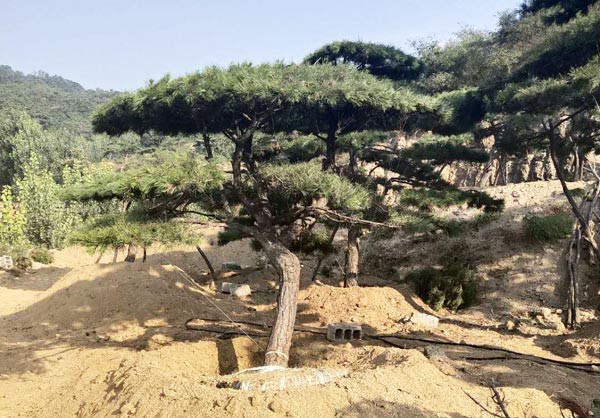



Author:pine trees pubData:2019/5/13 9:10:25

Growth Habits of Sculpted Oil Pine
The crown of the sculpted oil pine is typically tower-shaped or conical in its youth, transitioning to an oval or irregular trapezoidal shape in middle age. Isolated mature trees often exhibit a flat-topped crown that can be rounded or umbrella-shaped. The trunk is robust and upright, forming a tall silhouette, and can occasionally develop a curved, intricate form, giving it a vigorous and stately appearance.
Morphological Characteristics
The oil pine (also known as red pine or shortleaf pine) belongs to the Pinaceae family and is a needle-leaved evergreen tree that can reach heights of up to 30 meters with a diameter at breast height of up to 1 meter. The bark at the lower part of the trunk is grayish-brown, breaking into irregular scales, while the upper bark is reddish-brown. The larger branches are horizontally oriented or ascend at an angle, with older trees often displaying a flat top. The smaller branches are robust, glossy, and yellowish-brown, lacking a white powdery coating. The winter buds are oval-shaped with a pointed tip and a slight resin presence, covered with reddish-brown bud scales.
The needles grow in bundles of two, are dark green, relatively stiff, and range from 10 to 15 (up to 20) centimeters in length and 1.3 to 1.5 millimeters in diameter. The edges have fine serrations, and both sides contain stomatal lines. The cross-section of the needles is semi-circular, with the underlying cells arranged in a discontinuous two-layer formation. The resin ducts number from 3 to 8 (up to 11), located on the edges, with the occasional central duct at the angles and back. The leaf sheaths are initially light brown and later turn to a pale blackish-brown. The male cones are cylindrical, measuring 1.2 to 1.8 centimeters in length, clustered in spikes at the lower part of new shoots. The immature cones of the current year's growth are ovoid, yellowish-brown or yellow-green, and upright.
Growth Characteristics
The sculpted oil pine is a light-loving species; however, young trees can tolerate some shade. They exhibit strong cold resistance and prefer slightly acidic to neutral soils, showing sensitivity to saline-alkaline conditions. As a deep-rooted species, the main root system is well-developed and penetrates vertically into the ground, while lateral roots are also extensive, spreading horizontally and primarily concentrating in the upper soil layers.
Oil pines are not overly demanding regarding soil nutrients and moisture; however, they do require well-aerated soil for optimal growth, thriving particularly well in sandy soils. Poor growth is often observed in overly compacted soils or where excess moisture leads to poor aeration, which can manifest as early needle dieback. They do not thrive in areas with high groundwater levels or seasonal waterlogging. Additionally, the absorption roots of the oil pine have symbiotic mycorrhizae, indicating that they have specific cultivation requirements.